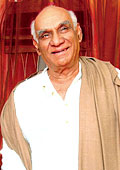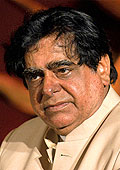 |
Subhash Ghai
Promoter & Chairman, Mukta Arts
BEST KNOWN FOR: Blockbusters like Hero, Ram Lakhan,
Saudagar, Khalnayak, Taal and Pardes
THE ROAD AHEAD:
A training institute called Whistling Woods; a music label,
Mukta Music, has been just launched; plans to focus on distribution
and exhibition, as well as production; closely eyeing new
areas like publishing (trade journals), radio and television |
Think
Bollywood and the image that will flash before most eyes is that
of a hero and heroine prancing around trees in exotic locales,
lip-syncing a (usually) bawdy song. Yawn; so what's new? A lot,
actually. Away from the public gaze, there's a radical transformation
sweeping across tinsel town, which, in a few years, can change
the face of the Indian film industry.
When UTV Motion Pictures released its most
recent film, Hattrick, in the theatres, it also simultaneously
released it online, through rajshri.com, the online portal of
the Rajshri Group. The first download for the film was from Mexico
and the second from South Korea-not the most obvious markets for
a Bollywood film, but it confirmed, if confirmation was needed,
the reach and demand for Hindi films in distant corners of the
globe. "I'm changing the way Indians watch films. The objective
is to take Bollywood to a global audience," says a visibly
excited Rajjat A. Barjatya, Managing Director, Rajshri Media,
which owns rajshri.com. Barjatya, a Harvard University alumnus,
launched his site in November last year to coincide with the release
of Rajshri Production's Vivah. Other old production houses like
the late Ramanand Sagar's Sagar Arts and B.R. Chopra's B.R. Films
are also reinventing themselves.
 |
Rajjat A. Barjatya
Managing Director, Rajshri Media
BEST KNOWN FOR: Hits like Dosti, Uphaar, Geet Gata
Chal, Maine Pyaar Kiya and Hum Aapke Hain Kaun
THE ROAD AHEAD:
Leverage rajshri.com by selling more films (not just its own)
online; make serials exclusively for the internet and mobiles;
aiming for 1 million hours of content on its site in five
years |
Welcome to the new Bollywood, where the name
of the game is now innovation. In the fast changing world of entertainment,
these old production houses, often under the management of second
and third generation scions of the founders, are becoming nimble-footed
and are looking hungrily for new business opportunities and alternative
revenue models. And slowly, from this melting pot of ideas, successes
and failures is emerging a Hollywood-style, professionally run,
studio model of film production. "For Vivah, we had 6,000
downloads at $9.99 (Rs 419.58) a pop. The numbers may be small,
but I look at it as a huge step for the Indian film industry,"
says Barjatya. On the anvil is a mobile portal. "In five
years, we will have one million hours of content on the site,"
he says. From the current level of 6,000 hours, that clearly spells
a new beginning for this old banner. Besides, Barjatya is talking
of putting television serials on the internet. "We are looking
at having 90 episodes of three minutes each in the first phase
of the project. It will be webisodes on the internet and mobisodes
on the mobile," he says. And he is not the only one who is
busy.
 |
Yash Chopra
Chairman, Yash Raj Films
BEST KNOWN FOR: Huge hits like Deewar, Trishul and
DDLJ
THE ROAD AHEAD:
Adopting the studio model; will have five releases in 2007
from five different directors; a new studio in western Mumbai
is up and running; a sharper focus on distribution; merchandising
and licensing are new areas being looked at |
For Sagar Arts, where the third generation
of the eponymous founding family is at work, 2007 marked its return
to film production after over 20 years. It released 1971, made
on a budget of Rs 10 crore, on March 9 this year. "We will
produce 4-5 films every year," says Amrit Sagar, a third
generation family member and director of 1971. The return to filmmaking
comes after its huge success in making TV serials-Ramayan, Shri
Krishna, Sai Baba and Alif Laila are a part of its vast library.
 |
B.R. Chopra
Promoter, B.R. Films
BEST KNOWN FOR: Films like Waqt, Humraaz, Dhund, Insaaf
ka Tarazu and Gumrah. Mahabharat (TV serial) was also from
the BR banner
THE ROAD AHEAD:
Animation; the first animation film is slated for release
next Diwali; expand distribution reach, overseas and in India;
will produce Mahabharat for the big screen; aims to produce
around 15 films over the next three years; a music label,
a larger presence on television and a new studio are in the
works |
Then, the group is also finalising its plans
of entering the theme park business. "We will launch our
first theme park this year," says Sagar Theme Parks' CEO
Shiv Sagar. He plans to have nine 100-acre theme parks, including
ones in Mumbai and Baroda, each costing Rs 100 crore. "The
revenues will come from entry fees, food courts and merchandise,"
he explains. These parks will have mostly mythology-based themes
and there could be an animated Ramayan to explain mythology to
Indian kids. Sagar is also working on a plan to build a film city-which
will be a one-stop shop for filmmakers-in Mumbai. "The way
I see it, we will increase our television content to nine hours
every day from four-and-a-half hours today. And we may also set
up a music company," says Sagar Arts' Director Prem Sagar
who is Ramanand Sagar's son.
The common thread running through these plans
of different production houses is diversification within the overall
remit of the entertainment and media industry. B.R. Films, another
well-established name in the business, is in the midst of a significant
transformation. "For the first time in almost 30 years, we
will be getting an outside director to make films under our banner.
Over the next three years, we should have about 12-15 releases,"
says B.R. Films' Group CEO Sanjay Bhutiani. Also on the anvil
is a foray into animation films, the first of which will be ready
for release by Diwali next year. Then, there's a plan to make
a two-part film out of Mahabharat, which it turned into a blockbuster
television serial in the 1980s. "The budget for the film
will be around $40 million (Rs 168 crore). On television, too,
we will have 4-6 products per year," says Bhutiani. "Our
USP over the years has been providing great content. In the next
18 months, we will have a full-fledged studio in operation; and
in five years, this will be a very professional organisation,"
he adds.
Studio Model
 |
Prem Sagar
Director, Sagar Arts
BEST KNOWN FOR: Ramayan (TV serial) and films like
Arzoo, Geet, Charas and Lalkar
THE ROAD AHEAD:
A return to film production (Salma was the last film he produced,
in the mid-80s); a film city for filmmakers; finalising plans
for nine theme parks; looking for a wider presence across
channels on television |
The emergence of the studio model is arguably
the most significant development in the industry over the last
few years. Yash Raj Films, the banner that perfected the model,
has also gained the most in the process. Consider this: of the
last 10 films from Yash Raj Films, only one, Veer-Zaara, was directed
by Yash Chopra himself. Last year's biggest grossers, Fanaa and
Dhoom-2-which grossed $36 million (Rs 151.2 crore) and $28 million
(Rs 117.6 crore), respectively, globally-were directed by others.
Yash Raj Films now straddles the entire cinema
value chain-from filmmaking to distribution to owning a music
label-and its stringent cost-control and global reach have made
it a money-spinner and the Bollywood label to watch out for. Its
new studio, YRF Studios, which is now up and running in western
Mumbai, has taken the studio model to a higher level.
Chopra has always spoken of having an "integrated
entertainment company" on the lines of a 20th Century Fox
or a Warner Brothers Entertainment. This year, his company has
five releases lined up, and not a single one is directed by Chopra
himself. "Our commitment to the studio style of functioning
allows us to make each offering different, though they are being
released at very close intervals," says the veteran producer-director.
Another producer who is sold on the studio
model is Subhash "Showman" Ghai. "Between 2008
and 2009, we will produce 6-10 films each year and will ramp this
up to 50 films a year by 2012," he says. His banner, Mukta
Arts, reaped rich benefits when it decided to produce Iqbal. "When
I make a film, I'm responsible for everything. But today, I can
depend on professionals," he adds. On the agenda is an increased
focus on Mukta Music, his recently-launched music label, distribution
and exhibition. That apart, Whistling Woods, his training institute
housed in Film City in western Mumbai, now takes up a large part
of his time. It is from here that Ghai is looking to get in new
talent. Meanwhile, he is also considering forays into publishing,
television and radio.
| FOR A FEW RUPEES MORE |
| Even as Bollywood's
biggest and oldest production houses attempt to spread wings
into newer areas, there's good news and bad news. The good
news? There are many avenues for funding, from public issues
to private equity to debt from banks. The bad news? Financiers
will take a close, hard look at projects to examine their
viability. They'll also take a close, hard look at the promoters,
to examine their accountability and discipline. As Mahesh
Chhabria, Director, 3i India, a private equity player, says:
"Whilst they are looking at new areas, it is important
for them to demonstrate competencies in these areas as well…
it is important for these players to have sustainable numbers
in their business models."
It is an industry where the risks often outweigh the returns,
and the markets are acutely aware of this. Explains Ravi
Sardana, Senior Vice President, ICICI Securities: "If
you are producing, say, six movies, it is important to have
a mix of high-budget and low-budget projects." To their
credit, by diversifying into new areas, the old production
houses are also spreading their risks. Industry analysts
give the example of Yash Raj model as an ideal one, as there
is no overdependence on one film. A presence in distribution
and music serve to make the model even more robust. The
upshot? A multi-revenue business model has a better chance
of being funded. "Whether we lend or not will be determined
by the robustness of the business model, the viability of
the project and the actual on-ground infrastructure that
has been put up," points out Jitender Balakrishnan,
Deputy Managing Director, IDBI Bank.
If none of the promoters is keen on making an initial
public offering (IPO), it may be because investors don't
have much faith in such companies. Companies that have gone
public before-including Mukta Arts, Cinevista and G.V. Films-
have flattered to deceive. Watching films is one thing,
investing in filmmakers quite another.
|
But there are some who are bucking this trend.
Producer-director Rakesh Roshan believes that the age-old practice
of independent filmmakers making one film at a time is working
quite well and doesn't wish to experiment with anything else.
"Over the next five years, I do not see this changing. I
will continue to make one or two films every one-and-a-half years,"
he says. Empirical evidence suggests that Roshan's formula also
works. In 2006, his banner, Filmkraft Productions, released Krrish,
which was the biggest hit of the year. His latest project, Krazzy
4, will be produced by him, but directed by his former assistant,
Raja Sen. Roshan clarifies that this is a one-off project and
does not mark his entry into the studio model of filmmaking.
But with the Barjatyas, the Chopras and the
Ghais of the world ushering in a new phase in Bollywood, Roshan
could be forced to quit playing contrarian and flow with the tide.
The consensus is that the studio model, with professional managements
and multiple revenue streams, is the good idea whose time has
come. Bollywood has willy-nilly emerged as the platform from which
an emerging India is projecting its soft power across the seven
seas. And it is the new avatars of the old and established production
houses that have taken it upon themselves to take the process
forward.
|









